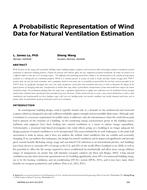
A Probabilistic Representation of Wind Data for Natural Ventilation Estimation
With the focus on low energy and sustainable buildings today, building designers, engineers and researchers alike increasingly attempt to incorporate natural ventilation in innovative building practices. Despite the interests and collective effort, one key component of natural ventilation, the wind, has proven to be a difficult riddle to solve due to its unsteady nature. The difficulty with predicting wind-driven airflow is the determination of the amount of wind power available as a driving force for ventilation purposes. While it is common practice to assume the wind is steady and often hourly averages from TMY3 weather data are used for wind estimation, such assumption could be error prone due to variability of wind within the one-hour interval provided by the TMY3 data. To specifically investigate this issue, this study incorporates several finer time-resolution wind data in order to determine the impact of the typical practice of averaging wind data. Incorporation of smaller time steps allows a probabilistic interpretation of how wind would have impact the nature ventilation design. The preliminary findings from this study show a significant improvement in airflow rate estimation over the traditional hourly averaged method when validated with experimental data provided in previous literature. Further work will aim to create a more robust distribution as well as both simulatively and experimentally test these findings using a full scale test building under real weather conditions and locally obtained wind data, and to further refine the probabilistic model of wind data used in such estimation.
Citation: ASHRAE and AIVC IAQ 2016 Conf
Product Details
- Published:
- 2016
- Number of Pages:
- 8
- Units of Measure:
- Dual
- File Size:
- 1 file , 1.3 MB
- Product Code(s):
- D-2016IAQ-28


